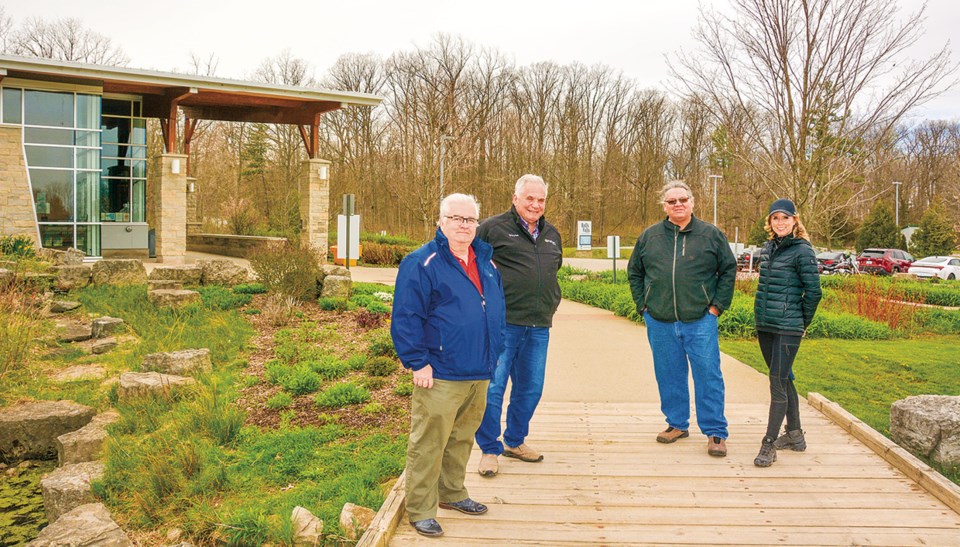Proponents say designation would boost tourism, draw international attention to various sites and Greenbelt
A Global Geopark is an area containing sites and landscapes of international geological significance, according to United Nations Educational, Scientific, and Cultural Organization (UNESCO), and Niagara is on the cusp of receiving Ontario’s first such designation.
The Niagara Peninsula Aspiring Global Geopark (NPAGG) is a non-profit entity that benefits Niagara residents, educational institutions, and business operators by fostering greater local geo-tourism, a concept that has been growing by leaps and bounds over the past 20 years. UNESCO is sending an assessment team to Niagara at the end of June.
A group of local advocates for the Niagara Geopark spoke with the Voice at Balls Falls recently to discuss the process.
“We're really thrilled that the Canadian Geopark Network will be sending representatives to Niagara to evaluate our Geopark and our various tourism, cultural, and Indigenous assets of which we are so proud,” said NPCA Manager of Conservation Area Services, Dr. Alicia Powell.
“Originally, [Balls Falls] had well over 1200 acres that was gifted by the government to the United Empire Loyalists, and Butler’s Rangers, who'd fought in the War of 1812,” said Powell. “The Ball family purchased several hundred acres and settled here back in the early 1800s. The Balls Falls Conservation Area today covers about 78 hectares, extending towards Jordan Harbour on the 20 Mile Creek.”
Powell noted the region’s significant geological, cultural, and heritage sites and assets, including the Native Centre in Niagara-on-the-Lake, several museums in the peninsula, and conservation areas like Balls Falls, Rockway, St. Johns, and the Wainfleet Bog and Wetlands.
Niagara Regional Councillor and NPCA Chair Rob Foster shared Powell’s enthusiasm.
“Within the Conservation Authority, there are all sorts of reviews going on to start tying together our trail systems. Our timing is absolutely perfect, not only for the Geopark, but a wide variety of other projects,” he said.
Pelham Town Councillor and Niagara Peninsula Aspiring Geopark Agriculture & GeoFood Working Group Chair Wayne Olson said that the Geopark “offers a vision that appeals to people with interests in sustainability, inclusion, truth and reconciliation, and many other important community commitments. The upcoming visit by the Geopark assessors is great chance for community groups to enroll as co-creators. I certainly want to see Pelham’s green culture represented.”
Olson said that he views his involvement as a personal act of reconciliation.
“It’s been a learning curve for me to become more knowledgeable about indigenous peoples of Niagara,” he said. “It’s given me another perspective that I think is very valuable. We were taught that our history started in 1492, with a series of heroes, wars, and conquests. Now we have a chance to reconcile with the Indigenous peoples who based their existence on cooperation and sharing.”
We were taught that our history started in 1492, with a series of heroes, wars, and conquests
Geopark Indigenous Culture Working Group Chair Phil Davis said that the Niagara landscape has helped support peoples who have lived here for thousands of years.
“I see the research possibilities, bringing all the information forward,” said Davis. “Living here my whole life, I am aware of those with a lot of knowledge about the traditional territory of the Haudanosaunee and Anishinaabe peoples, through stories that have been passed down through generations. There are artifacts dating back thousands of years that are held at the museum in Fort Erie. This area was a huge North American trade route.”
With support from the Greenbelt Foundation, the Niagara Peninsula Aspiring Global Geopark has developed partnerships that include tourism, conservation, academic, agricultural, and Indigenous organizations. Project partners include the Niagara Peninsula Conservation Authority, Niagara College, Great Wolf Lodge Niagara Falls Water Resort, Arterra Wines, Willowbank School for Restoration Arts, and Upper Canada Stone.
The UNESCO evaluation will last three to four days, and will include visits to different types of landscapes and cultural geosites with international significance. The evaluation team will also meet with tourism operators, municipal and provincial representatives, key Geopark team members, Indigenous stakeholders, and community members representing non-profit recreational groups.
Depending on the findings of the evaluation, the Niagara application could be forwarded to UNESCO this fall, with formal designation as a Global Geopark in 2023.




